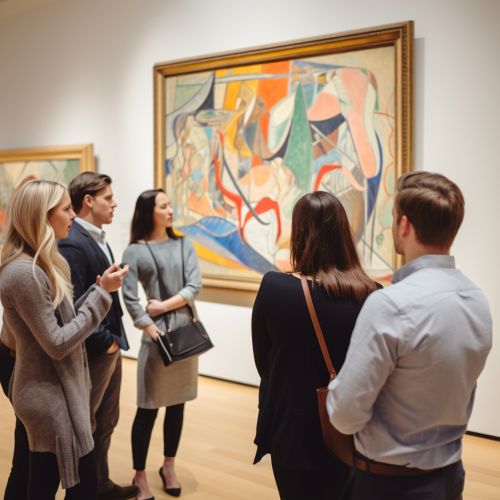Art criticism
Introduction
Art criticism is the discussion or evaluation of visual art. Art critics usually criticize art in the context of aesthetics or the theory of beauty. A goal of art criticism is the pursuit of a rational basis for art appreciation but it is questionable whether such criticism can transcend prevailing socio-political circumstances.
The variety of artistic movements has resulted in a division of art criticism into different disciplines which may each use different criteria for their judgments. The most common division in the field of criticism is between historical criticism and evaluation, a form of art history, and contemporary criticism of work by living artists.
History
Art criticism has many and often numerous subjective viewpoints which are nearly as varied as there are people practicing it. It is difficult to come by a more stable definition than the activity being related to the discussion and interpretation of art. The lack of a precise definition in this field allows for a multitude of perspectives to come forth.
Early criticism
The earliest use of the term art criticism was by the English painter Jonathan Richardson in his 1719 publication 'An Essay on the Whole Art of Criticism'. In this work, he attempted to create a systematic theory of art.
In the 19th century, art criticism became a more common vocation and even a profession, developing at the same time as photography and modern art. During this time period, art criticism was taken up by people who were not necessarily artists themselves, and who had a more intellectual approach to art.
Modern criticism
Modern art criticism is informed by Art Theory, which is the philosophical discussion of its methods and purposes. It is often influenced by aesthetics and art history, but it has also been influenced by psychoanalysis, psychoanalytic theory, and even economics.
Approaches to Art Criticism
There are several approaches to art criticism, including formalism, psychoanalysis, Marxism, and structuralism.
Formalism
Formalism is the analysis of works by their form or shapes in art history or archeology. It was an important aspect of modernism.
Psychoanalysis
Psychoanalysis in art criticism is an approach that uses the methods of psychoanalysis in the study of art and artists. Sigmund Freud's work has been particularly influential in this field.
Marxism
Marxism in art criticism is a form of critique that uses the principles of Marxism to analyze the creation and understanding of art. This approach views art as a product of labor and a tool for the bourgeoisie.
Structuralism
Structuralism in art criticism is an approach that views works of art as structures that can be understood through a study of their interrelated parts.
Criticism and Art Movements
Art criticism has played a significant role in the development of various art movements. Critics often serve as intermediaries between the art work and the public, interpreting the work and helping to shape public perception.
Impressionism
Impressionism was one of the first art movements to be significantly influenced by art criticism. Critics such as Louis Leroy attacked the Impressionists for their departure from traditional painting styles.
Cubism
Cubism was another movement that was heavily influenced by critics. Critics such as Louis Vauxcelles and his call to reject the 'bizarre cubiques' of Pablo Picasso and Georges Braque helped to galvanize public opinion against the movement.
Abstract Expressionism
Abstract Expressionism was a movement that was heavily influenced by critics. Critics such as Clement Greenberg championed the movement and helped to shape public perception of it.
Role of the Art Critic
The role of the art critic is a highly debated topic. Some view critics as essential interpreters of art, while others see them as unnecessary intermediaries.
Critics often play a key role in shaping the reputations of artists and their work. They can bring attention to new artists and can often influence public opinion. However, they can also be seen as gatekeepers, controlling access to the art world.
Critics are often seen as having a significant influence on the art market. Their reviews can impact the prices of artworks and can play a role in determining which artists are represented by galleries.
Conclusion
Art criticism is a complex field with a rich history and a wide variety of approaches and perspectives. It plays a significant role in the art world, influencing public perception of art, shaping the reputations of artists, and impacting the art market.
See Also


